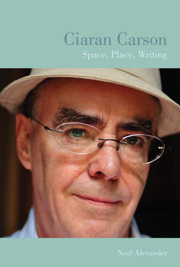Book contents
- Frontmatter
- Contents
- Acknowledgements
- Abbreviations
- Introduction
- Chapter 1 Imaginative Geographies: The Politics and Poetics of Space
- Chapter 2 Mapping Belfast: Urban Cartographies
- Chapter 3 Deviations from the Known Route: Reading, Writing, Walking
- Chapter 4 Revised Versions: Place and Memory
- Chapter 5 Spatial Stories: Narrative and Representation
- Chapter 6 Babel-babble: Language and Translation
- Bibliography
- General Index
- Index of Works
Chapter 1 - Imaginative Geographies: The Politics and Poetics of Space
- Frontmatter
- Contents
- Acknowledgements
- Abbreviations
- Introduction
- Chapter 1 Imaginative Geographies: The Politics and Poetics of Space
- Chapter 2 Mapping Belfast: Urban Cartographies
- Chapter 3 Deviations from the Known Route: Reading, Writing, Walking
- Chapter 4 Revised Versions: Place and Memory
- Chapter 5 Spatial Stories: Narrative and Representation
- Chapter 6 Babel-babble: Language and Translation
- Bibliography
- General Index
- Index of Works
Summary
The singularity of a literary work, argues Derek Attridge, is best understood as an event in which the reader experiences both inventiveness and alterity. Each reading constitutes ‘an appreciation, a living-through, of the invention that makes the work not just different but a creative reimagination of cultural materials’. My contention is that the singularity of Ciaran Carson's writing rests upon his far-reaching imaginative engagements with ideas of space and place, and particularly urban spatiality in an Irish context. It is the purpose of this chapter to set out a critical framework for exploring these engagements in their widest manifestations. Carson's oeuvre, in poetry, prose, and translations, is in many ways remarkably diverse and eclectic, ranging as it does across generic, geographical, linguistic, and disciplinary boundaries with seeming effortlessness and voracious enthusiasm, insistently placing ‘literature’ within the constellations of a wider universe of discourse and deliberately eschewing distinctions between ‘high’ and ‘low’ cultural forms. He is restlessly inventive in his experiments with form, combining and reworking a wide range of poetic structures and metres with elements adapted from fictional and non-fiction prose narratives, music and popular song, the visual arts and vernacular speech patterns. However, in spite of this propensity for variety there is little doubt that the city of Belfast occupies a central place within Carson's heterogeneous texts, functioning as a sort of imaginative focal point around which his many other concerns – music, language, narrative, memory, history – are arrayed, like spokes on the hub of a wheel.
- Type
- Chapter
- Information
- Ciaran CarsonSpace, Place, Writing, pp. 23 - 56Publisher: Liverpool University PressPrint publication year: 2010

